Webb’s Depth of Knowledge (DOK) is a powerful framework developed by Norman Webb to categorize learning tasks based on the level of cognitive complexity required. Instead of focusing solely on what students are doing, DOK examines how deeply they must think to complete a task, challenging them beyond surface-level understanding. This guide provides educators with insights on effectively using Webb’s DOK to enhance curriculum design, formative assessment, and differentiated instruction, ultimately promoting cognitive rigor.
The model consists of four levels, ranging from basic recall of facts to extended strategic thinking and reasoning. DOK encourages teachers to move beyond rote learning and instead engage students in activities that require them to analyze, evaluate, apply, and reflect. This makes it a powerful tool for increasing cognitive rigor across the curriculum.
Originally developed for large-scale educational assessments, DOK is now widely used in classrooms to ensure that students are being challenged at the appropriate level. It aligns well with modern approaches to curriculum design, formative assessment, and differentiated instruction.
Key Features of Webb’s Depth of Knowledge:
- Levels of Cognitive Demand: Tasks are categorized into four levels, from simple recall (Level 1) to extended thinking (Level 4).
- Focus on Thinking, Not Activity: DOK classifies the depth of cognitive processing, regardless of whether the task looks simple or complex on the surface.
- Supports Rigorous Teaching: Helps educators design and sequence tasks that build from basic understanding to advanced, independent application.
In the sections that follow, we’ll explore how Webb’s Depth of Knowledge can be applied in real classrooms, how it compares to other models of thinking, and why it plays a critical role in promoting meaningful, lasting learning.
Understanding the 4 Levels of Webb’s Depth of Knowledge
Webb’s Depth of Knowledge framework offers a structured approach to designing and evaluating tasks that require deeper cognitive engagement. It’s particularly useful in standardized assessments, where tasks are designed to test different levels of rigor.
Each of the four levels of Webb’s DOK builds upon the previous one, demanding greater levels of cognitive complexity:
- Level 1: Recall: This foundational level requires learners to simply recall information from memory, such as basic terms, definitions, or historical facts.
- Level 2: Skill/Concept: At this level, learners must demonstrate an understanding of concepts or skills. Activities include explaining concepts, interpreting data to support claims, and summarizing key ideas from texts.
- Level 3: Strategic Thinking: This level requires learners to apply their knowledge and understanding in different contexts, such as analyzing primary sources to support an argument, developing research questions, or creating interdisciplinary projects.
- Level 4: Extended Thinking: The highest level of DOK requires learners to engage in critical thinking, synthesize information, and evaluate arguments. Activities might include evaluating sources, synthesizing information from multiple sources to create new knowledge, developing original ideas, or assessing the validity of arguments.
It is essential to recognize that each level builds upon the previous one. At the first level, learners must recall basic knowledge, and at the second level, they must demonstrate understanding of the concept. In the third level, they must apply their knowledge in different contexts before finally engaging in critical thinking and synthesis at the highest level.
To further clarify the levels, consider a complex concept, such as climate change. At the recall level, learners might be asked to define climate change or name the greenhouse gases. At the understanding level, they might be asked to explain the causes of climate change or interpret data.
At the application level, learners might be asked to apply their knowledge by creating a proactive plan to reduce carbon emissions. Finally, at the highest level, learners might synthesize information from multiple sources to develop a solution to mitigate the negative effects of climate change.
Webb’s DOK is a powerful tool for educators, creating a common language for discussing levels of cognitive complexity, designing instructional activities, and evaluating student progress. By considering the four levels of rigor, educators can craft learning experiences that meet students where they are and move them towards greater depth of knowledge.
Defining ‘Depth of Knowledge’ in Detail
Depth of knowledge (DOK) is a concept used to assess the level of cognitive complexity required for students to complete a specific task. Introduced by Dr. Norman Webb in 1997, DOK categorizes tasks based on cognitive demand. This helps teachers understand students’ capabilities and design appropriate learning experiences to foster deeper understanding.
While often visualized using a DOK wheel, it’s important to remember that the wheel is a tool to display different cognitive resource demands which allow teachers to more easily identify the DOK level required for a given activity, and not the DOK itself.
Webb’s 1997 study provides a framework for categorizing DOK into four levels of rigor. Each level builds on the previous one, and requires learners to engage in greater levels of cognitive complexity.
It is important to note that the DOK levels are not fixed and may vary depending on age group, subject, and context. By using DOK, teachers can create tasks that challenge students and encourage deeper learning.
| DOK Level | Question Stems |
|---|---|
| Level 1: Recall | Who, What, When, Where, Why? How would you define…? Can you recall…? |
| Level 2: Skill/Concept | Can you explain why…? How would you use…? What might you infer from…? |
| Level 3: Strategic Thinking | Can you formulate a theory for…? What is your interpretation of…? How would you solve…? |
| Level 4: Extended Thinking | How would you design a plan to…? What evidence can you present for…? How can you prove/disprove…? |
| These are just examples and the list can be expanded depending on the subject and the learning objectives. |
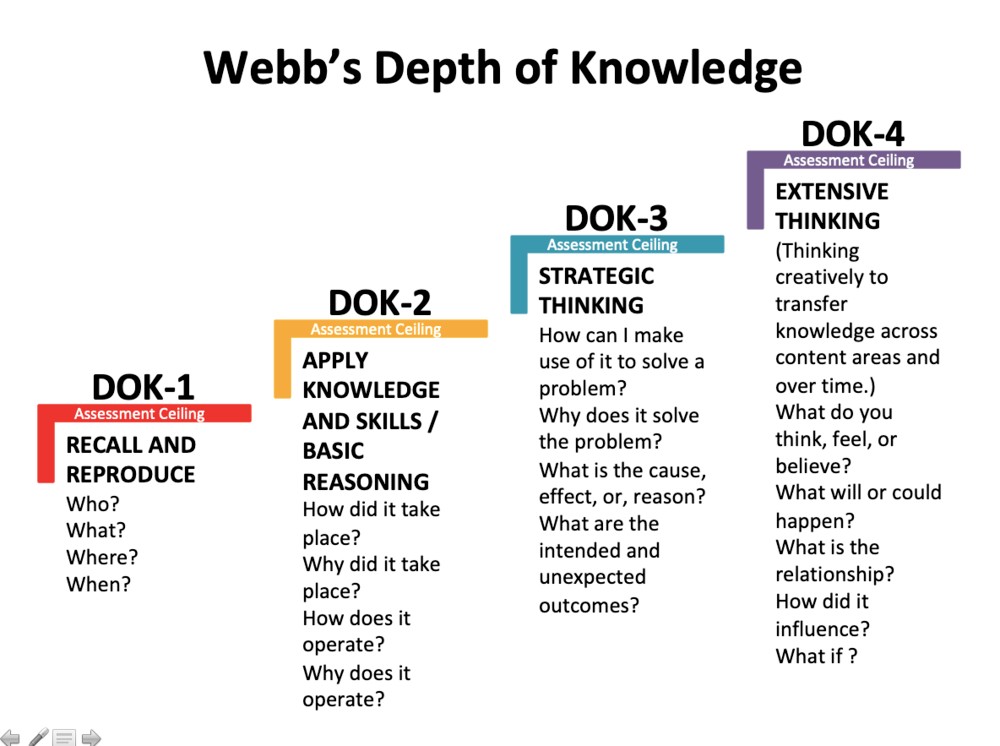
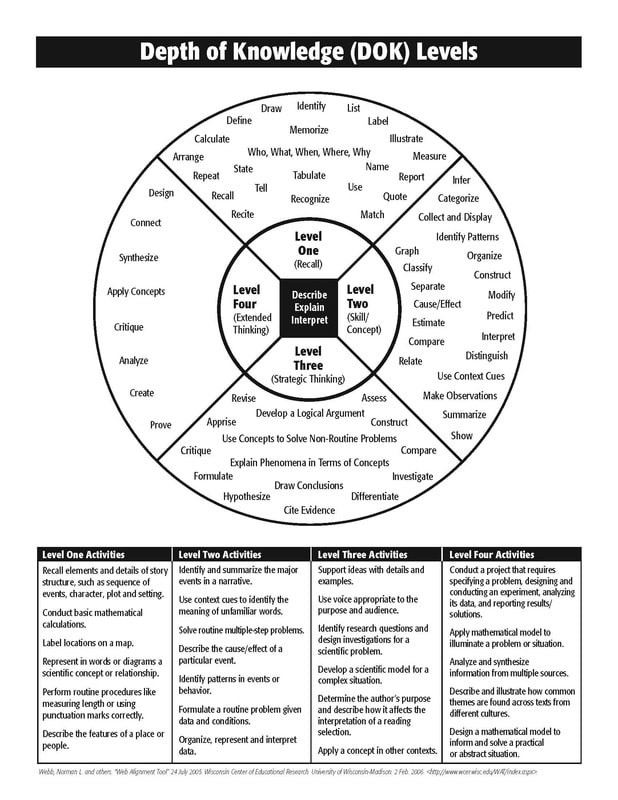
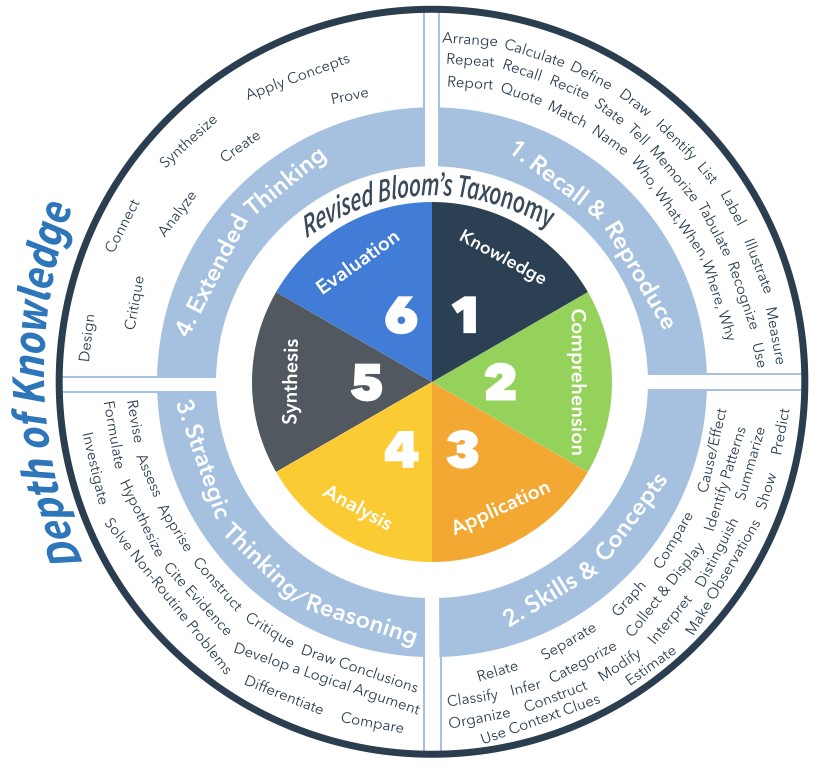
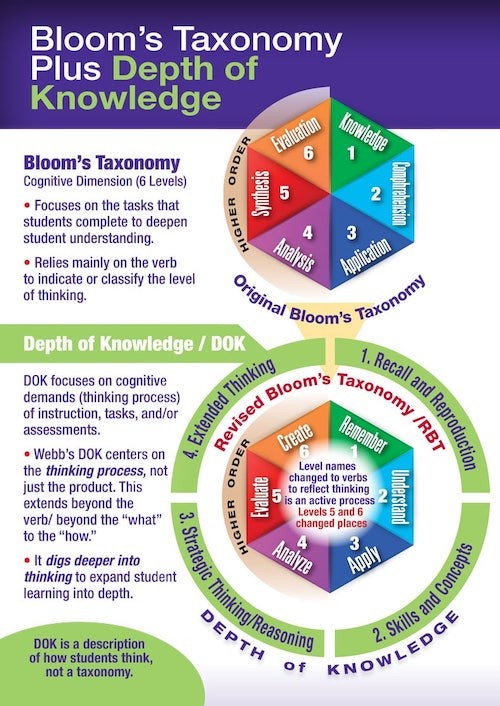
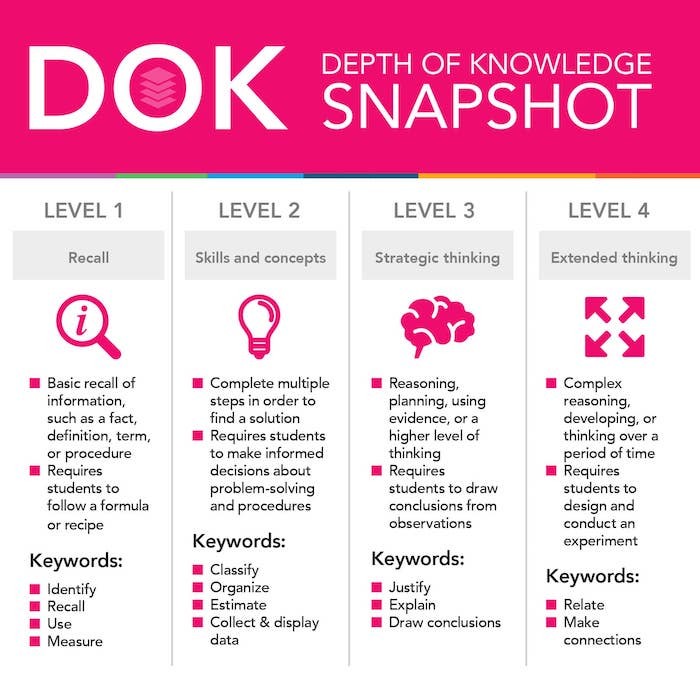
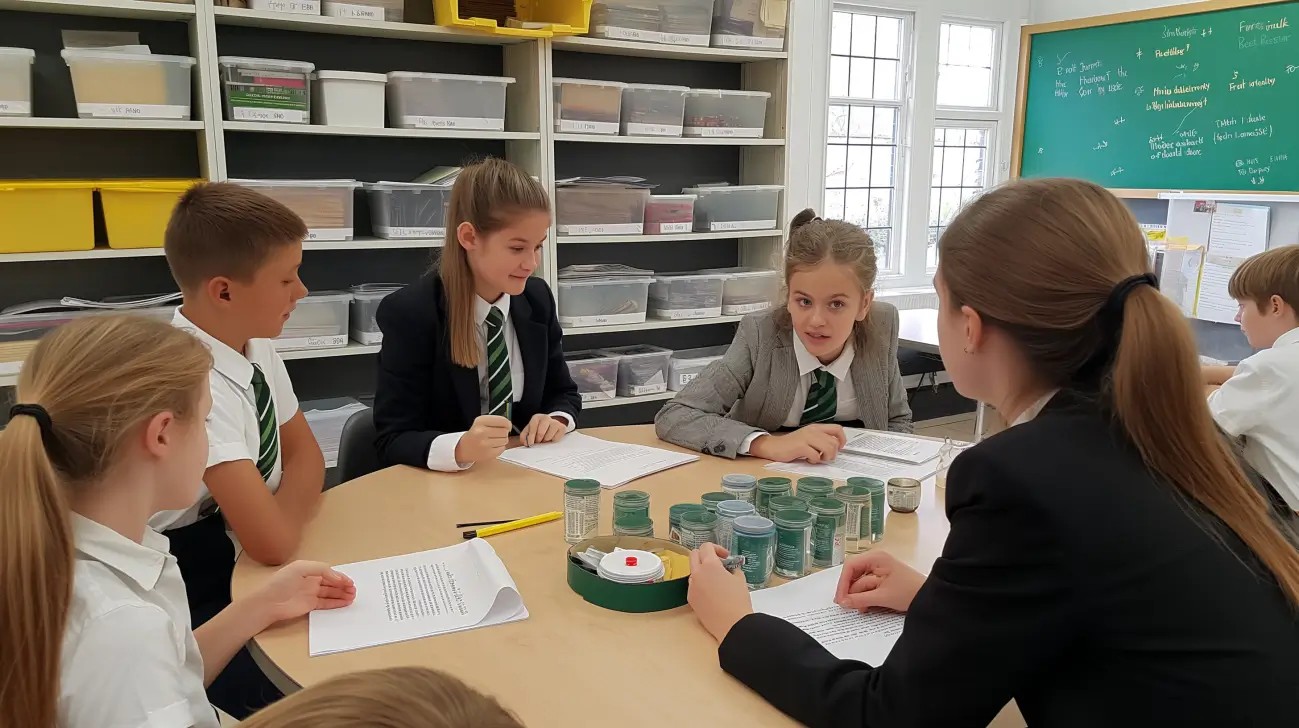
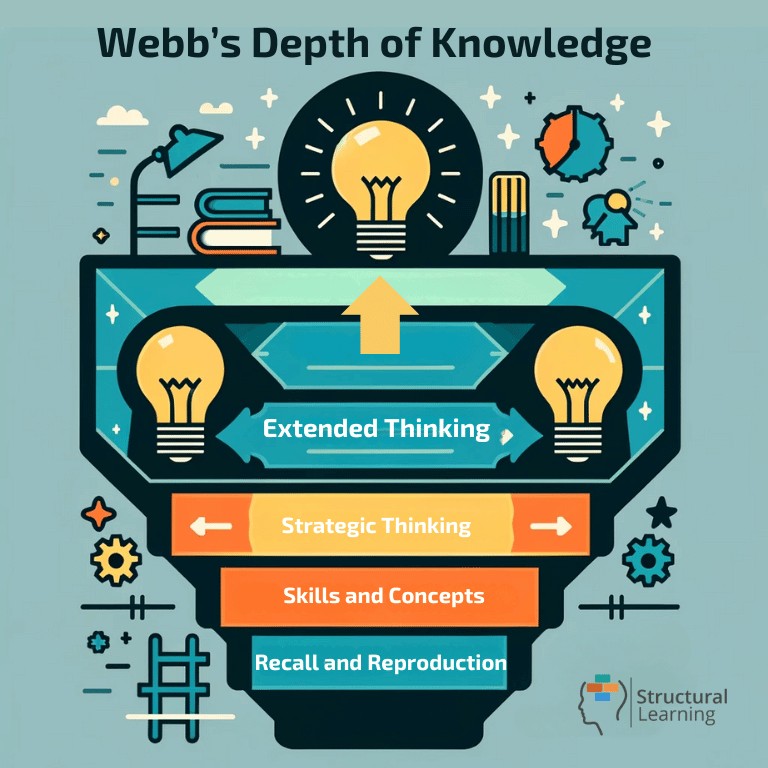
The Learning Theory Behind Webb’s DOK
The Webb learning theory, also known as Webb’s depth of knowledge (DOK) framework, was developed by Dr. Norman Webb in 1997. Dr. Webb is a respected education researcher and psychologist who has devoted his career to exploring the complexities of learning and cognition.
Dr. Webb’s motivation for developing the DOK framework was to provide educators with a clear and useful tool for measuring and promoting deeper student learning. The framework is designed to help teachers and learners identify the level of rigor required to complete a particular task or assignment, from basic recall to complex and nuanced thinking.
The DOK framework differs from other learning taxonomies, such as Bloom’s Taxonomy, in that it focuses less on the type of cognitive task and more on the level of rigor required to complete it. This means that the DOK framework is useful not just for designing and evaluating assessments, but also for guiding instructional practices that promote deeper learning.
At its core, the DOK framework consists of four levels of increasing rigor. Level 1 tasks require students to recall basic information. Level 2 tasks involve some degree of comprehension or application of concepts and skills. Level 3 tasks require students to apply their knowledge and understanding in new and varied contexts. Finally, level 4 tasks require students to engage in higher-order thinking, such as analysis, synthesis, and evaluation.
One of the key benefits of the DOK framework is its ability to promote deeper student learning. By focusing on the level of rigor required to complete a task, it encourages teachers and learners to engage in more complex and nuanced thinking. This means that students are able to develop their capacity for critical thinking, problem-solving, and cognitive flexibility, all of which are essential skills for success in today’s complex and rapidly changing world.
The Webb learning theory, or the DOK framework, provides educators with a valuable tool for measuring and promoting deeper student learning. Its emphasis on the level of rigor required for a task or assignment, rather than the type of cognitive task, makes it a useful tool for designing effective assessments and promoting instructional practices that encourage complex and nuanced thinking.
Comparing Bloom’s Taxonomy and Webb’s Depth of Knowledge
Bloom’s Taxonomy and Webb’s Depth of Knowledge (DOK) are two well-known learning frameworks used by educators to promote deeper student learning. While they share some similarities, there are also some important conceptual differences that set them apart.
One of the key differences between Bloom’s Taxonomy and Webb’s DOK is their conceptual approach. Bloom’s Taxonomy focuses on different types of cognitive tasks, from basic recall to more complex and abstract thinking, while Webb’s DOK focuses on the level of rigor required to complete a particular task or assignment. This means that Bloom’s Taxonomy is more focused on the type of thinking required, while Webb’s DOK is more focused on the level of cognitive complexity required to complete a task.
Another significant difference between the two models is their alignment with academic standards. Bloom’s Taxonomy is designed to align with content standards, which means that it focuses on specific subject matter and the level of thinking required to master it. In contrast, Webb’s DOK is aligned with performance standards, which are broader and more encompassing and focus on what students should be able to do with the knowledge they have acquired.
Despite these differences, both models share some similarities. For example, both frameworks emphasize the importance of promoting higher-order thinking skills, such as analysis, synthesis, and evaluation, and both can be implemented in the classroom to guide instructional practices that promote deeper student learning.
To implement Bloom’s Taxonomy in the classroom, teachers might present students with a variety of tasks that require different levels of thinking and cognition. For example, a level 1 task might involve asking students to recall basic information from a text, while a level 3 task might involve asking them to analyze and evaluate the author’s argument.
Similarly, to implement Webb’s DOK, teachers might use a wheel chart or rubric to assess the level of rigor required to complete a particular task or assignment and provide students with feedback that encourages them to engage in deeper and more complex thinking.
The strengths of each method are different. Bloom’s Taxonomy is useful for promoting critical thinking and problem-solving skills in specific subject areas. On the other hand, Webb’s DOK is ideal for promoting cognitive complexity across a wide range of subject areas and assignments. By using both methods together, teachers can create a more robust and comprehensive approach to promoting deeper student learning.
In conclusion, while there are some conceptual differences between Bloom’s Taxonomy and Webb’s Depth of Knowledge, both frameworks are effective tools for promoting higher-order thinking skills and can be implemented in the classroom in a variety of ways. By understanding the strengths and differences of each method, educators can create a more effective and comprehensive approach to promoting student learning and cognitive complexity.
How Webb’s Depth of Knowledge Increases Academic Rigor
Introducing rigorous instruction in the classroom is one of the most effective ways of helping students develop critical thinking skills and acquire knowledge that they can apply in real-world contexts. Webb’s Depth of Knowledge (DOK) is a framework that focuses on increasing rigor in classroom instruction by assessing the cognitive complexity of tasks and assignments. By understanding the four levels of rigor within the DOK framework, educators can design activities and assessments that help their students develop progressively more complex and sophisticated thinking skills.
Application of the DOK Levels
Educators can implement Webb’s DOK in their classroom instruction by designing activities and assessments that align with each level. For example, teachers can design Level 1 tasks that focus on simple recall of information, such as asking students to identify key vocabulary words or concepts from a reading passage.
Level 2 tasks might involve applying knowledge and skills to new situations, such as asking students to use mathematical equations to solve real-world problems.
Level 3 tasks are more complex and may require students to analyze and synthesize information from multiple sources or use multiple strategies to complete a task. An example of a Level 3 task might be asking students to compare and contrast the arguments of two different authors on a controversial issue.
Finally, Level 4 tasks involve extended thinking that goes beyond the classroom, such as asking students to use their knowledge and skills to analyze and solve complex real-world problems. For example, a Level 4 task might involve working on a project that requires students to evaluate the environmental impact of a new development in their community.
The DOK framework helps educators increase rigor in classroom instruction by assessing the cognitive complexity of tasks and assignments. By designing activities and assessments that align with each level of rigor, teachers can create a learning environment that promotes critical thinking, problem-solving, and the acquisition of knowledge and skills that prepare students for successful futures.
Implementing Webb’s DOK in Classroom Instruction
Webb’s Depth of Knowledge (DOK) framework is a pedagogical tool used to design and align activities, assessments, and instructional delivery. The framework’s four levels of complexity that are designed to challenge students’ critical thinking, problem-solving, and metacognitive skills. Understanding and implementing Webb’s DOK in classroom instruction is essential for designing lessons that challenge and foster students’ thinking skills at the appropriate level of rigor.
To implement Webb’s DOK in classroom instruction, teachers can design activities and assessments that align with each level of complexity. For example, teachers can design Level 1 tasks that focus on simple recall of information such as asking students to identify key vocabulary words or concepts from a reading passage. Activities that challenge Level 2 thinking might involve applying knowledge and skills to new situations such as asking students to use mathematical equations to solve real-world problems.
Level 3 tasks are more complex and often require students to analyze and synthesize information from multiple sources or use multiple strategies to complete a task. Teachers can design activities and assessments that challenge Level 3 thinking by asking students to compare and contrast arguments of two different authors on a controversial issue or to evaluate data from scientific experiments to draw conclusions.
Finally, Level 4 tasks involve extended thinking that goes beyond the classroom. Teachers can challenge students’ critical thinking skills by providing authentic learning experiences such as working on a project that requires students to analyze and solve real-world problems. For example, students could evaluate the environmental impact of a new development in their community or design solutions for reducing traffic congestion in their city.
Teachers can use Webb’s DOK to design lesson plans that challenge students at appropriate levels of rigor. By using the framework, teachers can align instructional delivery, activities, and assessments to maximize student engagement and learning outcomes. Teachers can also use DOK to differentiate instruction and accommodations for students with diverse learning needs. Activities can be modified to meet the unique learning needs of individual students based on their entry-level knowledge, learning styles, and learning challenges.
It is also important for students to use DOK to monitor their own learning progress. By understanding the levels of complexity, students can monitor their growth in critical thinking and problem-solving abilities. Students can use DOK to set growth targets, reflect on their learning progress, and identify areas of strength and weakness.
Teachers can incorporate active learning strategies such as authentic learning experiences, cooperative learning, and problem-based learning activities to challenge students at various levels of complexity. By implementing Webb’s DOK framework, teachers can promote a rich learning environment that challenges and enhances students’ thinking skills, resulting in deep learning and retention of knowledge.
Subject-Based Examples of DOK
The versatility of the DOK model makes it an excellent tool for educators to incorporate into lesson planning, regardless of the subject. By understanding the different levels of cognitive rigor required at each stage, teachers can create activities and assessments that challenge their students’ critical thinking and problem-solving skills. Let’s explore some subject-based examples of how teachers can effectively apply the DOK framework in their lesson planning:
ELA:
In ELA, teachers can use the DOK framework to create reading and writing activities that align with all four of Webb’s levels of complexity. For example, at Level 1, students could be asked to recall specific details from a text, such as identifying the main characters or setting. Level 2 tasks can challenge students to apply their knowledge of literary devices to analyze the text, such as identifying symbols or interpreting metaphors.
Level 3 tasks can be designed to challenge students to compare and contrast different perspectives in a text or drawing conclusions about character motivations. Finally, at Level 4, students could be asked to complete an extended writing project that requires them to use critical thinking and creativity to explore themes from the text in a real-world context.
Math:
In math class, teachers can use DOK to challenge students to apply their understanding of mathematical concepts to real-world problems. At Level 1, students can be asked to recall math facts and basic formulas. As they progress to more complex tasks, students can be asked to apply those facts and formulas to more complex problems, such as calculating the area and volume of three-dimensional shapes.
At Level 3, students could be challenged to use statistical data to analyze trends and make predictions, while Level 4 tasks could require students to apply mathematical principles to real-world scenarios, such as designing a bridge that can withstand certain environmental conditions.
Science:
In science classes, teachers can use DOK to challenge students to apply their knowledge to real-world phenomena. At Level 1, students could be asked to recall facts about the laws of physics or ecological systems.
As they progress to higher levels, students can be challenged to analyze and synthesize information from multiple sources to draw connections between various scientific principles. For example, students at Level 3 may be challenged to explain the impact of environmental factors on a specific species or predict the outcome of an experiment based on scientific principles.
Finally, at Level 4, students could be asked to design and execute scientific experiments that address real-world issues, such as developing alternative energy sources or evaluating the impact of climate change on ecosystems.
Assessment Creation:
It is crucial to make sure that students are exposed to tasks at all four levels of DOK to foster comprehensive learning and assess the varying levels of cognitive rigor. By incorporating the DOK framework into assessment creation, teachers can create assessments that accurately measure their students’ learning progress.
For example, a math exam could include Level 1 questions on basic concepts and formulas, Level 2 questions that focus on applying those formulas to solve problems, Level 3 questions related to data analysis and synthesis, and finally, Level 4 questions on real-world problem solving and application. This approach ensures that the assessment accurately measures students’ cognitive skills at all levels, and teachers can use the results to adjust their instruction accordingly.
In conclusion, teachers can use the DOK framework to design effective lesson plans that challenge students’ cognitive abilities across various subjects. The model’s versatility makes it a valuable tool for educators who wish to engage their students in meaningful learning experiences and ensure they develop the necessary skills to succeed in real-world contexts.
By incorporating DOK into assessment creation, teachers can also measure students’ learning progress comprehensively and adjust their instruction accordingly.
Utilizing Webb’s DOK in Special Education
Webb’s Depth of Knowledge (DOK) is a framework that helps educators structure lessons and assessments based on the complexity of thinking required. When teaching special education students, it is important to utilize DOK to ensure that each student’s unique pace and learning needs are taken into account.
One of the key considerations when applying DOK in special education is the individualized learning needs of each student. For example, teachers should consider the student’s preferred learning style, communication abilities, and areas of strengths when creating lesson plans. By doing so, teachers can create a tailored learning experience that aligns with each student’s strengths and limitations, while also ensuring that each student is challenged at an appropriate level of cognitive complexity.
To ensure that special education students stay engaged throughout the learning process, teachers should aim to create authentic learning experiences that link the concepts being taught to real-world contexts. This can help to give students a sense of purpose, and make the learning process more tangible and relevant. Using adaptive learning platforms with active learning strategies can also help to keep students engaged by providing a level of interactivity that is not possible with traditional teaching methods.
In addition, it is important for teachers to work collaboratively with professional learning coaches to develop DOK materials and lessons that are tailored to the specific needs of the special education student. This can help to ensure that each student is learning at an appropriate level of cognitive complexity, and that each student is being challenged in a way that is appropriate for their individual needs.
Overall, implementing DOK in special education requires a focus on individualized learning, authentic learning experiences, and collaboration with professional learning coaches. By taking these factors into account, teachers can create a rich learning environment that helps special education students achieve their full potential. The use of Solo Taxonomy can also enhance the implementation of DOK in special education.
Key Insights and Further Reading on Webb’s DoK
Here are five key papers or research articles discussing Webb’s Depth of Knowledge (DOK) and its implications in education:
1. Critical Thinking, Instruction, and Professional Development for Schools in the Digital Age by H. Coleman, Jeremy Dickerson, Dennis Dotterer (2017)
Summary: This paper emphasizes the use of Webb’s DOK as a theoretical guide to create flexible, student-centered instructional models in schools, promoting higher-level critical thinking skills and professional development.
2. Depth of Teachers’ Knowledge: Frameworks for Teachers’ Knowledge of Mathematics by V. Holmes (2012)
Summary: The study utilizes Webb’s DOK framework as a tool for classifying teachers’ knowledge in mathematics, providing a vocabulary for discussing and assessing their understanding at different school levels.
3. Taxonomies in Education: Overview, Comparison, and Future Directions by J. Irvine (2021)
Summary: Irvine analyzes Webb’s DOK as a popular taxonomy in education to compare knowledge, cognition, metacognition, higher-order thinking skills, and affect in learning environments.
4. Lecture Breakup- A Strategy for Designing Pedagogically Effective Lectures for Online Education Systems by Siddharth Srivastava, Shalini Lamba, T. Prabhakar (2020)
Summary: This article discusses the application of Webb’s DOK in designing quality lectures for online education systems, highlighting its relevance in traditional classroom-based teaching.
5. Quantifying Depth and Complexity of Thinking and Knowledge by Tamal Biswas, Kenneth W. Regan (2015)
Summary: The paper explores Webb’s Depth of Knowledge as a qualitative approach to cognitive rigor, assessing depth and complexity in Education Studies.
These papers provide insights into the application and significance of Webb’s DOK in various educational contexts, from teacher training programs to online learning environments, emphasizing its role in enhancing critical thinking and understanding at different levels of cognitive complexity.
Frequently Asked Questions about Depth of Knowledge (DOK)
As educators continue to explore new ways of improving student learning, there has been an increased popularity in using Webb’s Depth of Knowledge (DOK) framework. However, this framework can be quite complex and often leads to questions among educators about its purpose, implementation, and how it could benefit student learning.
To address these questions, we have created a Frequently Asked Questions (FAQs) section on DOK that aims to provide educators with a comprehensive guide to understanding this framework.
The purpose of this section is to offer essential insights on DOK, provide answers to most frequently asked questions, explain how to implement DOK in a meaningful way, and highlight the benefits for student learning.
Whether you are a teacher or a school administrator, you will likely find this section to be a valuable resource in understanding the different levels of cognitive complexity, the benefits of adopting this framework, how to determine the appropriate DOK level for your students, and how to use DOK to develop assessments and lesson plans that align with state standards.
Q1: What is Webb’s Depth of Knowledge (DOK)?
Webb’s Depth of Knowledge is a framework that categorizes tasks according to the complexity of thinking required to successfully complete them. It is used to analyze the cognitive expectation demanded by standards, curricular activities, and assessment tasks.
Q2: How many levels are there in Webb’s DOK?
Webb’s DOK is made up of four levels. Level 1 involves recall and reproduction, Level 2 involves skills and concepts, Level 3 involves strategic thinking, and Level 4 involves extended thinking.
Q3: How does Webb’s DOK differ from Bloom’s Taxonomy?
While both Bloom’s Taxonomy and Webb’s DOK are frameworks for classifying learning objectives, they are different in their focus. Bloom’s taxonomy is a hierarchy of the different levels of cognitive processing, while Webb’s DOK focuses on the complexity of mental processing that must occur to complete a task.
Q4: How can I use Webb’s DOK in my teaching?
Webb’s DOK can be used to ensure your instruction targets various levels of cognitive demand. By understanding the DOK levels of your teaching activities, you can better align these activities with assessments and learning objectives.
Q5: Can Webb’s DOK be used to create assessments?
Yes, Webb’s DOK is often used to guide the development of assessments, ensuring that they measure the intended cognitive processes. For example, you might design some questions to target lower DOK levels (e.g., recall of information) and others to target higher DOK levels (e.g., strategic and extended thinking).
Q6: Does Webb’s DOK align with Common Core State Standards?
Yes, Webb’s DOK has been used in the development of the Common Core State Standards to indicate the level of cognitive demand associated with each standard. The intention is to ensure a good balance of cognitive demands across each grade level.